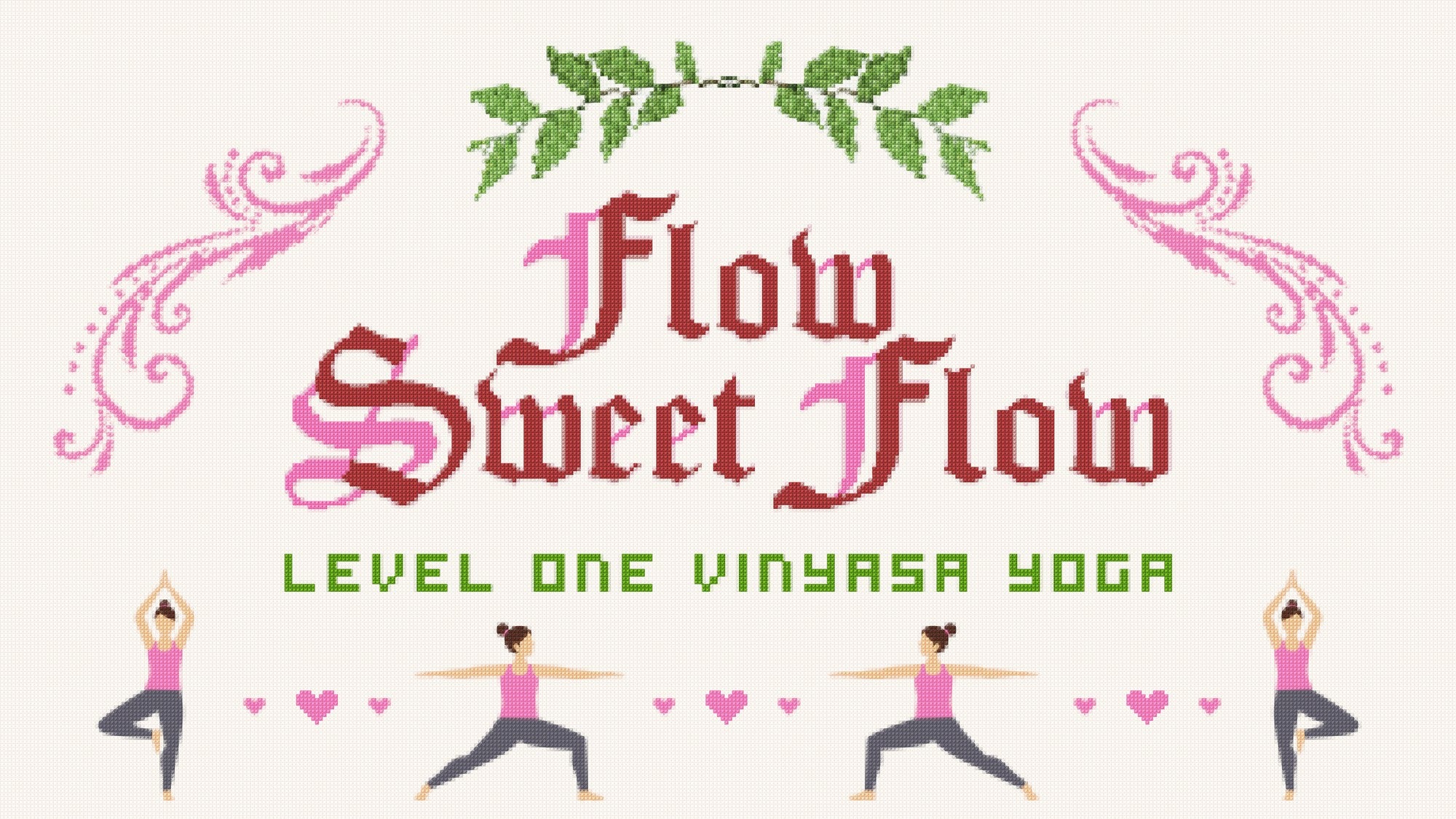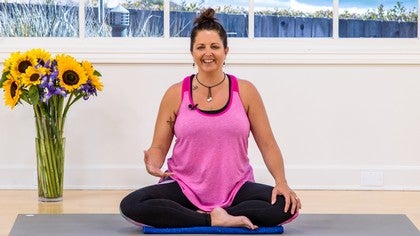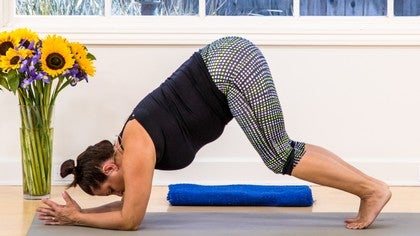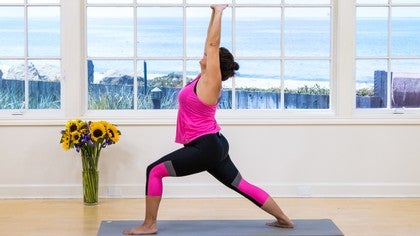Description
About This Video
Transcript
Read Full Transcript
(waves crashing) Welcome. So this tutorial is about the breath. Now one of the beautiful things about the Vinyasa sequences and the flowing nature of Vinyasa is it gives you the opportunity to really listen to the body and most specifically, the breath. How we treat the breath in yoga is it's very sweet actually. We develop a relationship with our breath.
So instead of thinking I need to exhale now, inhale now, it's more like this invitation of oh, I'd like to inhale now and I'm gonna invite the breath in. Oh okay, I'm gonna exhale and I'm gonna invite the breath out. So when you're practicing, it's sort of like you can think about when a good friend comes over, comes to dinner and the doorbell rings and you run to the door and you open the door and you're like so excited to see your friend, that's the relationship with the breath. Like oh, I'm so happy to see you and you're a little sad when the evening's over, but you're also a little glad, so it's the same with the exhalation, right? Now if you treat it in this way, what happens is a lot of relaxation moves in with the breath and even though you're listening to the teacher's signals about inhale now, exhale now, it'll have a relaxation quality to it.
Now, I don't know about you, but sometimes my mind will get in the way as I practice. If that happens to you, just let go of all of that stuff. Just let go of all of it and just follow the movements with the teacher and then you can step back up with the breathing. So the most important thing is that it feels good, it feels relaxed. Now, we're using these in conjunction with the movement of the body, so one of the unique things about the breath, naturally in the body, when we inhale naturally, our body really deep inside does a little bit of a back bend as we inhale and when we exhale naturally, our body really deep inside does a little bitty forward fold and the yogis recognized that a long time ago and so many of the postures when you're opening the body into a back bend or an arms over your head or anything like that, the teacher's instruction will be inhale here because it's already the natural, organic movement of the breath and maybe you're folding the body in and you'll here the instructor say, "Okay, here's where you exhale." So what is happening is you're being guided to listen not only to the instructor, but also to the natural quality of your breath and how it was basically designed for you to breathe.
When you do that, the whole system starts to calm down because it recognizes something natural is happening here. Even if your body isn't used to the postures, which at first may feel a little unnatural. So that's one of my favorite things to always to remember when I'm practicing myself. Now, when you go into that quality of following the breath and recognizing the breath in the movements or hearing the instruction, it's beautiful to recognize where the breath is going. So I kinda want to do a little something with you here just so you can sort of feel it.
So wherever you are, sitting or standing it doesn't matter, closing your eyes my help. Close your eyes and let yourself take a breath in and first I want you actually to focus on the way it feels around your nostrils when you inhale. Keep your eyes closed and then you'll exhale through the nostrils and focus on the nostrils and you'll feel that breath there. Notice again, when you inhale, right around the nostrils, the air is gonna feel cool and dry and then as you exhale, eyes still closed, you're gonna feel a warm, moist air leaving your body. Now, keep this breathing going.
It's real subtle and soft, you don't have to take these giant, crazy breaths at all, just normal breathing, but I'd like you to feel the side ribs open up as your inhale and then feel the side ribs relax as the exhale comes along. Again, you're trying not to make yourself breathe, you're simply observing here comes the inhalation, I'd like to feel it more in my back body. Oh okay, I felt that, here goes the exhalation. Yes, I felt a little change. Here comes the inhalation, I feel it now.
Say to yourself, I feel it now in the front body. Then feel it in the front body as you exhale. Sometimes you'll be given the instruction of maybe where to look and that does give the mind something to do with in the practice, but other times you may want to guide your breath this way during the practice. The final thing for this little segment is to show you a breath that is used a lot in Vinyasa and this breath is very ancient and it is a tool for keeping you focused on your breath. It's called Ujjayi breath and in the Ujjayi breath, we're still recognizing relaxation.
We're still recognizing that there is this relationship going on between you and your breath, but it gives you a focus, it gives you a focus. It's so easy to do, I can't even tell you how easy. In fact, I'm just gonna show you. So make sure your eyes are open for this because you're gonna wanna see these cues, they're fun. So you're gonna keep your mouth closed and with your mouth closed, as you inhale, you're going to whisper your name with your mouth closed.
So I'll do it for you if you want to see. It looks like this. (inhales loudly) Just like that and then I'm gonna keep my mouth closed and whisper my full name as I exhale. (exhales loudly) So go ahead and try that, you probably already have. Try it again.
The mouth is closed. As you breathe in, you're whispering your full name. (inhales loudly) As you exhale, you're whispering your full name, mouth stays closed. (exhales loudly) You probably like everyone, feel a different quality on the inhalation compared to the exhalation; super normal, but also what you may or may not recognize is that by asking you to whisper your name, you're activating your vocal cords a little bit and that activation of the vocal cords is what gives you the ability to really hear the breath and that gives you that beautiful focus, alright? So I'd like for you to try it a few more times.
Really you can still use the whispering your name thing, alright, but you're feeling the inhalation and exhalation. I'll do a few with you as well. Remember, you're keeping the relaxation and you're keeping that friendly relationship while you're doing this. So here we go. On the inhalation, whispering your name with your mouth closed and we'll continue on from there.
(inhales loudly) (exhales loudly) (inhales loudly) (exhales loudly) Keep going. I want you to try it now without having to whisper your name, but still getting that tonal quality of activating the vocal cords. (inhales loudly) (exhales loudly) Maybe one more, keep the eyes relaxed. (inhales loudly) (exhales loudly) And let's rest. Now, sometimes when you are doing this and first learning it, you might feel a little light-headed, that's normal.
The suggestion is if you start feeling that way during the class that you're experiencing, just breathe normally. Don't worry about it. You'll fall into this really graceful pattern with the Ujjayi breath; it feels really lovely and the focus is wonderful. For me, it reminds me of when I'm under the water and I'm breathing under the water like if you have a scuba gear on or if you're floating in water and your ears are covered and you can hear your breath. So it's so super relaxing and so greatly beneficial.
And then the final thing that I would like to mention about it is as you're creating that breath, you're gonna notice that you have a much greater control of your breath in a way; it's slowing down the inhalation and it's slowing down that exhalation. So be conscious of that if you suddenly become winded, that's all that is, is your body is not used to slowing the breath down that much and may be you're doing something that's causing the whole system to need more oxygen. So don't worry if that happens as well, just go back to normal breathing, even if you have to gulp some breaths, whatever. You will learn and your body will learn how to create a beautiful pace with this. So that's some exploration with the breath.
Take it into all of your classes. Enjoy yourself and all of the mini instructors. We thank you and have a beautiful practice. Namaste.
Flow Sweet Flow: Laura Tyree
Comments
I love how it's no matter how long we practice something it just gets deeper and deeper....ujjayi was my first taste of pranayama.....it continues to get richer, sweeter. Falling in love with the breath again and again is such bliss!!
So glad you enjoy your practice!
Hugs
You need to be a subscriber to post a comment.
Please Log In or Create an Account to start your free trial.











